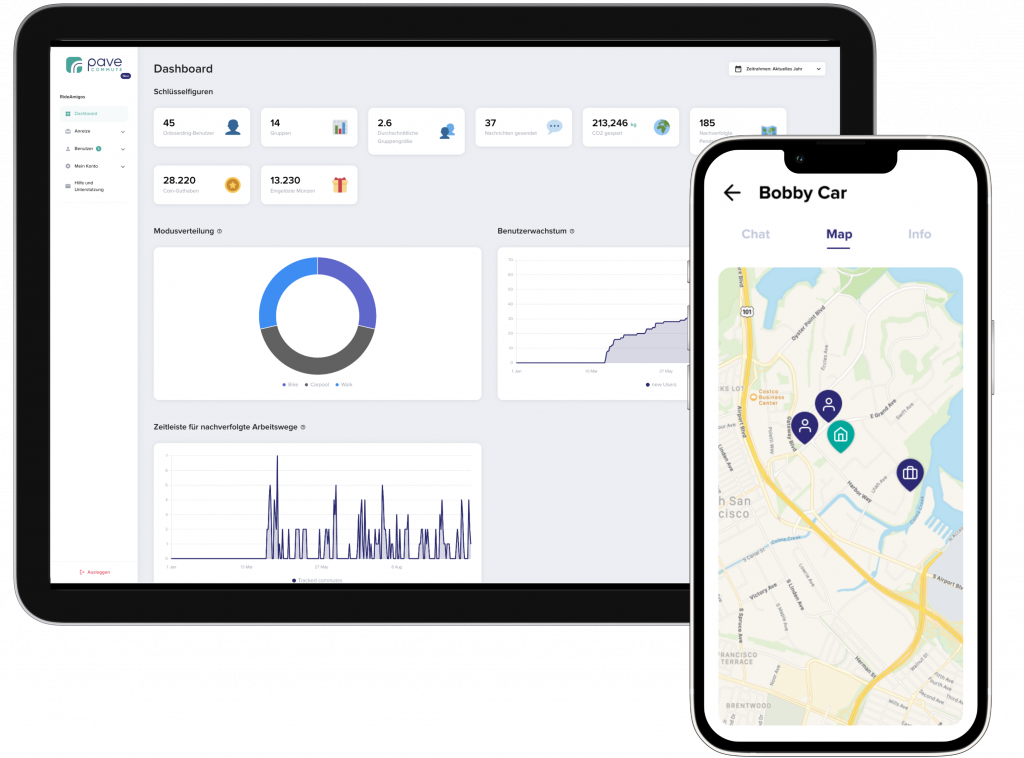Carsharing, ridesharing, carpooling, ridepooling, ridehailing – with so many terms out there, it’s easy to get confused. But these mobility options are NOT the same!
In this guide, we’ll break down the differences, the pros and cons of each, and why Pave Commute is the best solution for commuters looking to share rides and cut costs.
The Quick Answer
- Carsharing = Sharing a car, but not necessarily the ride. You rent a car for personal use for a specific time.
- Ridesharing = Sharing a ride in someone else’s car, often splitting the cost of the trip.
Now, let’s dive deeper!
What is Carsharing?
Carsharing allows multiple people to use the same car at different times instead of owning a personal vehicle. It’s typically accessed via mobile apps and platforms, making it a flexible alternative to car ownership.
Types of Carsharing Services
- Free-floating carsharing → Cars can be picked up and dropped off anywhere in a designated area. Example: ShareNow, Free2move.
- Station-based carsharing → Vehicles must be picked up and returned to specific locations. Example: Zipcar, Getaround.
- Corporate carsharing → Companies provide shared vehicles for employees, either free or with a mobility budget. Example: Some universities and tech campuses offer carsharing spots for staff.
Pros of Carsharing
✔️ Reduces car ownership & environmental impact
✔️ No maintenance, insurance, or repair costs
✔️ Great for occasional drivers
What is Ridesharing?
Ridesharing is when a driver shares their ride with others going in the same direction. This option helps cut costs and reduce congestion, making commuting more efficient and sustainable.
Carpooling, Ridepooling & Ridehailing – What’s the Difference?
- Carpooling → Regularly scheduled shared rides, like commuting to work together. Example: Pave Commute.
- Ridepooling → Shared rides on-demand, often via a ridesharing app. Example: Via, Moia.
- Ridehailing → Requesting a ride through an app where a driver picks you up. Example: Uber, Lyft.
How can I find a rideshare?
- Company bulletin board – A classic method, but not very efficient.
- WhatsApp groups or internal communication – Often problematic for data privacy, since most people are reluctant to share their personal address publicly.
- Apps like Pave Commute – The app automatically identifies potential carpooling matches within a company and calculates who would benefit most from sharing a ride.
Pros of Ridesharing
✔️ Cuts commuting costs – Save up to $572 per year with just one carpool partner!
✔️ Reduces traffic and parking issues
✔️ Lowers CO₂ emissions – One car emits around 404 g of CO₂ per mile
✔️ Strengthens workplace connections
Which is More Sustainable?
At first glance, carsharing seems eco-friendly since fewer people own cars. But if each trip is still a solo ride, it doesn’t reduce traffic or emissions.
Ridesharing, on the other hand, maximizes existing trips by filling empty seats, cutting CO₂ emissions, and reducing fuel consumption.
For companies, Pave Commute makes it easy to start carpooling, helping businesses lower their carbon footprint and offer meaningful employee benefits.
Why Pave Commute is the Best Ridesharing Solution
✅ Find the perfect carpool match – Just seamless ride coordination.
✅ Earn rewards for sustainable commuting – Points, challenges & recognition.
✅ Save big on commuting costs – Up to $572 per year!
✅ More than just ridesharing – Incentives for biking, walking & public transit too!
Why still ride alone?
Start your FREE 30-day trial today and see how Pave Commute makes carpooling easy and rewarding!



